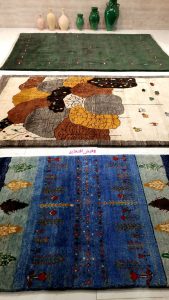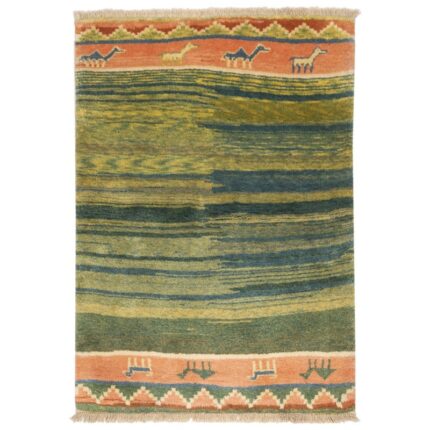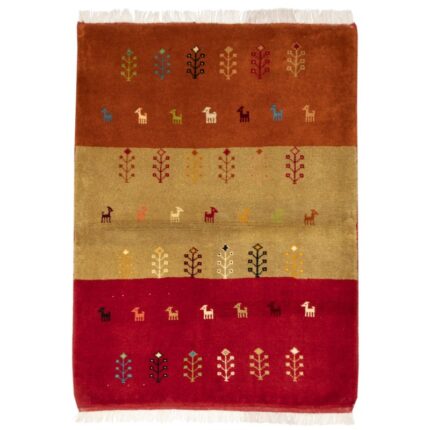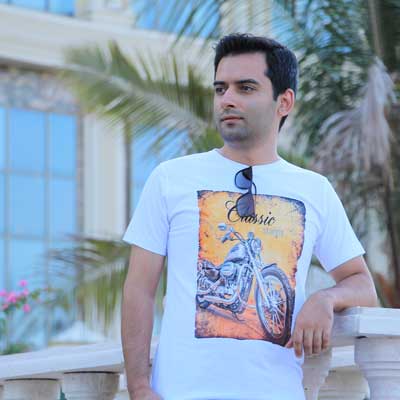Persian Gabbeh Rugs
Persian Gabbeh Rugs
Persian Gabbeh rugs are among the most beautiful, intricate, and unique. These rugs are hand-knotted in Iran and are renowned for their bold, vibrant colors, intricate patterns, and traditional designs. Gabbeh rugs, which translate to “raw” or “unfinished” in Farsi, are often seen as a reflection of the nomadic lifestyle of the people who make them.
They are made from natural wool and dyed with vegetable dyes, creating a one-of-a-kind piece of art that will be admired for years to come.
Persian Gabbeh rug from Ersaly online shop can be a great choice. Not only are they beautiful and functional, but they are also made with the finest materials and handcrafted with care. Whether you’re interested in a traditional design or a more modern look, there is a Gabbeh rug that can suit your taste and style.
Introduction to Persian Gabbeh Rugs
Gabbeh rugs are a type of Persian rug that is hand-knotted in Iran. Characterized by their bold, bright colors and intricate patterns, Gabbeh rugs are often seen as a reflection of the nomadic lifestyle of the people who make them. They tend to be thicker and softer than traditional Persian rugs and are often made with natural wool dyed with vegetable dyes. These rugs have been used for centuries and have become a timeless and beloved part of many homes.

History of Persian Gabbeh Rugs
The history of gabbeh rugs dates back to the 16th century when the nomadic tribes of Iran began producing these beautiful and intricate art pieces. The nomads were known for their weaving and dyeing skills, and their Gabbeh rugs were renowned for their bold, vibrant colors, intricate patterns, and traditional designs.
The nomads used natural wool and vegetable dyes to create these rugs, and they often used motifs from their culture and beliefs to create unique and beautiful pieces.
In the 18th century, the production of gabbeh rugs spread to other parts of the world, and they quickly became popular as decorative pieces in homes in the Middle East, Europe, and the United States. Today, Gabbeh rugs are still prized for their unique beauty and craftsmanship, and they are often seen as a reflection of the nomadic lifestyle of the people who make them.
Types of Persian Gabbeh Rugs
There are several types of Gabbeh rugs, including Kashkuli Gabbeh rugs, one of the most popular and widely recognized ones. These rugs are usually larger than traditional gabbeh rugs and often feature bold, geometric patterns and bright colors.
- The Kashkuli Gabbeh is often seen as a reflection of the nomadic lifestyle of the people who make them, and they are often used as a centerpiece in a room to add a touch of color and character.
- Other Gabbeh rugs include the traditional Gabbeh, which is usually smaller and features more intricate, delicate patterns. This type of rug is often seen as a reflection of the nomadic lifestyle of the people who make them, and it is often used in more formal settings and as an accent piece.
- Vintage gabbeh rugs are another popular type of Gabbeh rug, and they are often sought after for their unique and intricate designs.
- Modern gabbeh rugs are also popular, often featuring bold, geometric designs and bright colors. These rugs are often made with synthetic materials and often used as a statement piece in a room.
These rugs are usually made with natural wool and vegetable dyes, often featuring traditional motifs and designs. These rugs can be difficult to find, but they are often prized for their unique and beautiful craftsmanship.
What is Kashkuli Gabbeh Rug?
A Kashkuli Gabbeh rug is an intricate and unique Persian rug hand-knotted by the nomadic tribes in Iran. The design of these rugs is highly ornate and includes intricate patterns composed of geometric shapes and symbols. The colors used in these rugs are often bright and vibrant, giving them a distinct look and feel. The Kashkuli Gabbeh rug is known for its durability and softness, making it a desirable choice for any home. With proper care and maintenance, these rugs can last for generations.
What are the Differences between Gabbeh and Kilims?
Gabbehs and Persian Kilim are traditional handwoven flat-weave carpets or rugs in many cultures worldwide. Both are made from wool, but there are several differences between them.
Gabbehs are usually thicker and more heavily constructed than kilims, with more dense and sturdy pile. Gabbeh rugs are often decorated with abstract geometric designs, while kilims usually feature stylized motifs, such as flowers, birds, and animals. Gabbeh rugs are usually made in muted colors, while kilims often feature brighter and more vibrant hues. The knots used in weaving Gabbehs are usually larger and more relaxed than those used in kilims, resulting in a more relaxed and abstract appearance.
Overall, Gabbehs are heavier and denser, with abstract patterns, while kilims are thinner and feature more intricate motifs in brighter colors.
Persian Gabbeh Rug Prices
Prices for Gabbeh rugs vary depending on the size, design, and material used. Smaller, simpler designs usually start at around $100, and high-end designs can cost as much as $1,500 or more. The exact price will depend on the intricacy of the design and whether it is Persian-made. Additionally, the quality of the materials used, such as wool, and the knots per square inch in the rug are also factors that can influence the price. The larger the rug, the more expensive it will be.
Crafting Persian Gabbeh Rugs
Crafting a gabbeh rug is long and intricate, requiring much skill and patience. The rugs are made from natural wool and vegetable dyes, often featuring intricate patterns and design unique to the weaver.
This process is often seen as a reflection of the nomadic lifestyle of the people who make them, and it is a testament to their skill and dedication.
Styles of Persian Gabbeh Rugs
There are several styles of gabbeh rugs, ranging from traditional to modern. Traditional gabbeh rugs often feature intricate, delicate patterns and are often seen as a reflection of the nomadic lifestyle of the people who make them. These rugs are often used in more formal settings, and they are often used as an accent piece.
Benefits of Persian Gabbeh Rugs
Gabbeh rugs are not only beautiful and unique, but they also offer many benefits. They are often made with natural wool and vegetable dyes, which makes them a safe and eco-friendly choice.
They are also incredibly durable and can last for many years with proper care and maintenance. In addition, gabbeh rugs are known for their bold, vibrant colors and intricate patterns, which can add a touch of character and personality to any room.
How to Choose the Right Persian Gabbeh Rugs?
When choosing a Gabbeh rug, consider the size and type you need. A larger Kashkuli Gabbeh rug may be the best choice for a statement piece. A smaller, traditional gabbeh rug may be the better option if you’re looking for an accent piece. It’s also important to consider the colors and patterns of the rug, as they can help to create the desired look and feel of a room.
Where to Buy Persian Gabbeh Rugs?
Gabbeh rugs can be found in many places, including online retailers, antique stores, and specialty rug stores. When buying a gabbeh rug online, look for reputable retailers offering a wide selection of various colors and styles. It’s also important to read customer reviews to ensure you’re getting a quality product.
When shopping for a gabbeh rug in an antique or specialty rug store, it’s important to inspect the rug closely to ensure it is of good quality. It’s also important to ask questions about the rug, such as where it was made and how it was crafted, to ensure you get a quality product.
Are Persian Gabbeh Rugs good quality?
Care and Maintenance of Persian Gabbeh Rugs
It’s important to properly care for and maintain your Gabbeh rug to ensure it lasts many years. It’s important to vacuum the rug regularly to remove dirt and debris and to spot-clean any spills or stains as soon as possible. Rotating the rug regularly is also important, as this will help prevent uneven wear.
It’s also important to avoid direct sunlight and extreme temperatures, as these can cause the rug’s colors to fade. If the rug is placed in a high-traffic area, it’s important to use floor protectors underneath it to prevent wear and tear.
Persian Gabbeh rugs are among the most beautiful and unique rugs in the world. They are hand-knotted in Iran and renowned for their bold, vibrant colors, intricate patterns, and traditional designs. These rugs are often seen as a reflection of the nomadic lifestyle of the people who make them, and they are sure to be admired for years to come.
FAQ:
What is a Persian Gabbeh Rug?
A Persian Gabbeh Rug is a traditional Persian rug originating from the nomadic tribes of Iran. It is known for its unique texture, high-quality wool, and rustic design.
What are the typical colors of a Persian Gabbeh Rug?
The colors of a Persian Gabbeh Rug are usually earthy tones, such as browns, greys, and beige. Some Gabbeh rugs also feature brighter colors, such as reds and blues, but the color scheme is typically subdued.
Are Persian Gabbeh Rugs expensive?
The cost of a Persian Gabbeh Rug can vary depending on its size, design, and wool quality. However, they are generally more affordable than other Persian rugs due to their simple design and rustic charm.
Are Gabbeh Rugs Good quality?
Gabbeh rugs are renowned for their high-quality, soft, and natural fibers. These rugs’ bright and vibrant colors also make them stand out, making them a popular choice for decorating homes. Gabbeh rugs are usually hand-knotted and can be quite thick and heavy, making them resistant to wear and tear. Additionally, because of their craftsmanship, Gabbeh rugs can last for many years without losing their quality, making them an excellent investment.
What is Kashkuli Gabbeh Rug?
Today, Gabbeh Rugs are offered various names: Standard, Amalehbaft, Kashkooli, Luribaft, Sumak, and also Baluch Gabbeh Gabbeh Kashkooli is a carpet with a greater knot thickness and also much shorter heap than routine Gabbeh rugs.



































